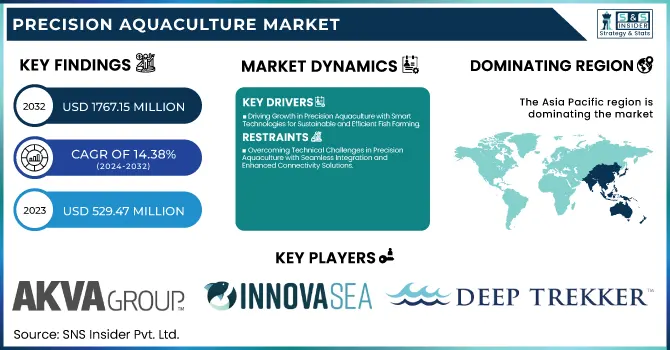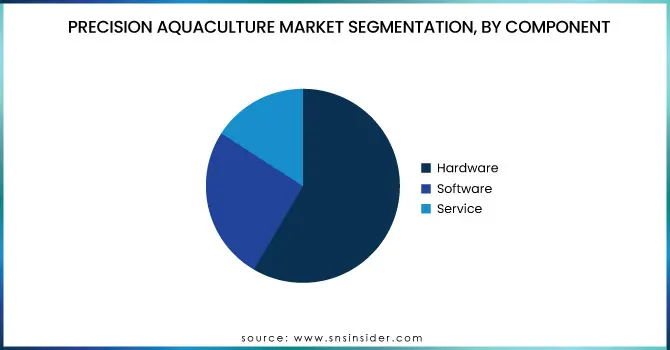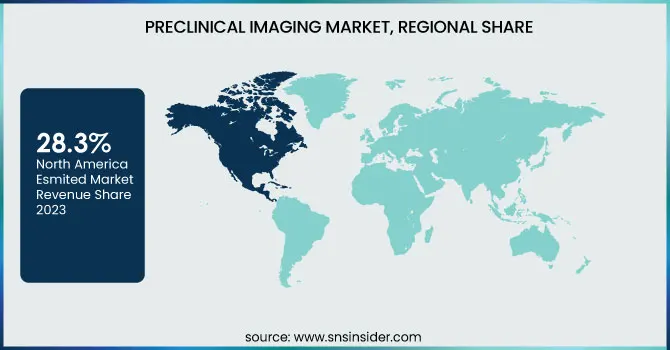Precision Aquaculture Market Size & Industry Insights:
The Precision Aquaculture Market Size was valued at USD 529.47 million in 2023 and is expected to reach USD 1767.15 million by 2032, growing at a CAGR of 14.38% over the forecast period 2024-2032. The precision aquaculture market is in a rapid evolution phase in terms of adoption & technology, with the use of modern technology including IoT, AI, and data analytics to make fish farming operations more efficient and cost-effective. More operational & performance capabilities with automated feeding systems, monitoring, and predictive maintenance.

To Get more information on Precision Aquaculture Market - Request Free Sample Report
Smart sensors and imaging tools used to predict fish behavior contribute to fish health & welfare by enabling the best conditions and lowest disease outbreaks. Additionally, system performance improvements focus on reliable hardware-software integration and reliable communication solutions for aquaculture operations by ensuring the collection and analysis of data to support integrated-detection-based decision-making.
Precision Aquaculture Market Dynamics
Key Drivers:
-
Driving Growth in Precision Aquaculture with Smart Technologies for Sustainable and Efficient Fish Farming
There are several drivers in the precision aquaculture market, as efficiencies and sustainability in fish farming are becoming increasingly important. Growing Trend of Smart Fish Farming Using IoT Sensors, AI Data Analytics & Automated Feeding Systems It also helps to monitor the water quality, overall fish health, and feeding patterns in real-time, helping ease waste and produce better. Also, the increasing need for sustainable seafood production is steering farmers towards precision solutions to minimize environmental damage. Increasing investment in aquaculture infrastructure, along with government support towards smart farming techniques, further enhances the market growth. Additionally, awareness of the economic advantage precision systems provide like minimized feed expenses and increased yield is fueling the market expansion.
Restrain:
-
Overcoming Technical Challenges in Precision Aquaculture with Seamless Integration and Enhanced Connectivity Solutions
The precision aquaculture market has been experiencing some pressing challenges due to technical complications and integration complications. Utilization of advanced systems including IoT sensors, AI-powered monitoring tools, and automated feeding systems needs technical knowledge and technical proficiency. Aquaculture farmers, particularly in small-scale farms, will have difficulty in the calibration of systems, data interpretation, and troubleshooting. Moreover, real-time data transmission can be limited in monitoring and control systems due to remote or offshore aquaculture sites where connectivity problems exist, making it difficult to achieve an effective monitoring and control process. Another challenge that persists is that of integrating different hardware and software solutions across various farming environments into a seamless solution.
Opportunity:
-
AI-Driven Solutions and Data Analytics Unlock Growth Opportunities in Precision Aquaculture Technologies
There is a huge scope for an AI-enabled monitoring platform and a data-driven decision-making tool in the market. This includes feed prediction analytics for disease detection and automated adjustments in feeding those types of systems would be more widely adopted. As offshore aquaculture expands and recirculating aquaculture systems (RAS) become more popular, precision aquaculture technologies will continue to find new opportunities. Further, the heightened weather handling on use sustainability presents prospects for eco-friendly innovations made to maximize efficiency. Firms that are implementing cloud-based platforms, machine learning algorithms, and biometric monitoring tools stand to benefit from a better competitive position in the face of a changing market.
Challenges:
-
Enhancing Data Security and System Interoperability for Safe and Scalable Precision Aquaculture Solutions
A connected aquaculture system has all the same data security and privacy risks that you would have in any other connected environment, which is another significant hurdle. Modern farms are becoming more vulnerable to threats from cybercrime, and area and technical system malfunctions as more farms adopt cloud-based platforms and remote monitoring solutions. The mitigation of risk to sensitive data feeding schedules, environmental conditions, and operational insights is paramount to maintaining business continuity. Furthermore, the absence of uniform guidelines regarding data sharing and system interoperability can limit the scalability of precision aquaculture technology. Solutions will involve better cybersecurity approaches, greater operator technical training, and greater consensus on standards to provide for the interoperability of systems.
Precision Aquaculture Market Segments Analysis
By Component
The hardware segment dominated the overall precision aquaculture market, with a maximum share of 58.4% in 2023. The rapid adoption of devices, such as smart feeding systems, sensors, cameras, and other monitoring equipment, which are essential for maintaining optimal health and farm productivity for their fish, spurred this dominance. Incorporating appropriate hardware technologies is still necessary to gather real-time data on water quality, temperature, and fish behavior.
The software segment will grow at the highest from 2024 to 2032 These growth drivers include increasing demand for AI-based analytic platforms, cloud-based data management, and predictive modeling tools that provide timely and resource-optimized decision-making power. The growing number of benefits that come along with data-driven insights is leading aquaculture operators to drive technologies like advanced software solutions for better management.

By System
In 2023, the precision aquaculture market was dominated by Smart Feeding Systems, which held 46.6% of the total market. The large share can be credited to the high adoption rate of automated feeding solutions which not only distribute the feeds evenly but also reduce the feed wastage and make the growth of the fish very effective. Sensors and artificial intelligence are used in smart feeding systems to feed determined amounts of feed (based on fish behavior and external conditions) while ensuring higher efficiency and cost-savings.
The Monitoring and Control Systems segment is anticipated to grow at the fastest CAGR from 2024-2032. The increasing demand for real-time water quality monitoring, automated environmental control, and data-driven farm management is driving this growth. The capabilities offered by the development of IoT-powered sensors, intelligence (AI) analytics, and remote monitoring platforms are driving the adoption of systems that provide aquaculture operators with not only decision support but also precision aquaculture.
By Application
Feed Optimization held the largest share of the precision aquaculture market in 2023, accounting for 52.6% of the total market. The need for automated feeding solutions that help increase fish growth, minimize feed wastage, and improve total farm efficacy was chiefly responsible for this dominance. Using powerful sensors and artificial intelligence (AI) algorithms, feed optimization systems enable accurate feeding schedules and management, allowing aquaculture operators to achieve better resource use and cost savings.
The Monitoring & Surveillance segment is expected to grow at the fastest CAGR during 2024-2032. Increasing demand for real-time monitoring of water quality, fish behavior, and environmental management is contributing to this growth. In aquaculture, it is progressively turning to direct IoT empower gadgets, submerged cameras, and AI-empower investigation to validate the presence of the ranch, keep up the perfect condition, and avoid dangers.
Precision Aquaculture Market Regional Landscape
The precision aquaculture market in the Asia Pacific region held the highest share of 34.5% in 2023. The reason for this dominance is comprehensive aquaculture in the region (China, India, Vietnam, and Indonesia). They have been focusing on advanced feeding systems, water quality monitoring, and automated farm management systems for their seas to optimize seafood production for several decades. A good example is the fishery in Indonesia, which has recently made a huge success By Component smart feeding that can increase feed efficiency and fish growth. Likewise, in China, IoT sensors and AI-based monitoring platforms are being implemented on large-scale aquaculture farms for sustainable seafood production to meet the growing need for protein-rich diets.
From 2024 to 2032, Europe will grow the fastest with a CAGR, thanks to rising investments in sustainable aquaculture practices, along with superior monitoring solutions. Norway, Scotland, and Denmark, for example, are harnessing new technologies to improve fish welfare and environmental management. Consider Bluegrove in Norway, which has developed AI-assisted monitoring tools that follow fish behavior, feeding habits, and environmental conditions for ideal conditions at farms. Furthermore, European regulations encouraging environmentally sustainable aquaculture management practices continue to drive precision aquaculture technology adoption in this region.

Get Customized Report as per Your Business Requirement - Enquiry Now
Key Players
Some of the major players in the Precision Aquaculture Market are:
-
AKVA group (Polarcirkel Cages)
-
InnovaSea Systems (AquaMesh Monitoring System)
-
Steinsvik (ScaleAQ) (iFarm Fish Welfare System)
-
Deep Trekker (DTG3 Underwater Drone)
-
Aquabyte (Fish Health Monitoring Platform)
-
Eruvaka Technologies (Smart Feeder)
-
Akuakare (Smart Feeding Technology)
-
CPI Equipment (Aquaculture Feed Systems)
-
Lifegard Aquatics (Water Quality Test Kits)
-
Bluegrove (Sensory Monitoring Solutions)
-
Imenco AS (Subsea Camera Systems)
-
In-situ (Aqua TROLL Water Quality Sensors)
-
Signify (Aquaculture LED Lighting)
-
Jala Tech (Water Quality Monitoring Device)
-
Planet Lighting (Submersible LED Lights)
Recent Trends
-
In January 2025, AKVA Group unveiled its next-generation air dome for the Nautilus concept, enhancing deep-sea farming efficiency by improving oxygen supply and fish welfare.
| Report Attributes | Details |
|---|---|
| Market Size in 2023 | USD 529.47 Million |
| Market Size by 2032 | USD 1767.15 Million |
| CAGR | CAGR of 14.38% From 2024 to 2032 |
| Base Year | 2023 |
| Forecast Period | 2024-2032 |
| Historical Data | 2020-2022 |
| Report Scope & Coverage | Market Size, Segments Analysis, Competitive Landscape, Regional Analysis, DROC & SWOT Analysis, Forecast Outlook |
| Key Segments | • By Component (Hardware, Software, Service) • By System (Smart Feeding Systems, Monitoring and Control Systems, Underwater ROV Systems) • By Application (Feed Optimization, Monitoring & Surveillance, Yield Analysis) |
| Regional Analysis/Coverage | North America (US, Canada, Mexico), Europe (Eastern Europe [Poland, Romania, Hungary, Turkey, Rest of Eastern Europe] Western Europe] Germany, France, UK, Italy, Spain, Netherlands, Switzerland, Austria, Rest of Western Europe]), Asia Pacific (China, India, Japan, South Korea, Vietnam, Singapore, Australia, Rest of Asia Pacific), Middle East & Africa (Middle East [UAE, Egypt, Saudi Arabia, Qatar, Rest of Middle East], Africa [Nigeria, South Africa, Rest of Africa], Latin America (Brazil, Argentina, Colombia, Rest of Latin America) |
| Company Profiles | AKVA group, InnovaSea Systems, Steinsvik (ScaleAQ), Deep Trekker, Aquabyte, Eruvaka Technologies, Akuakare, CPI Equipment, Lifegard Aquatics, Bluegrove, Imenco AS, In-Situ, Signify, Jala Tech, Planet Lighting. |

